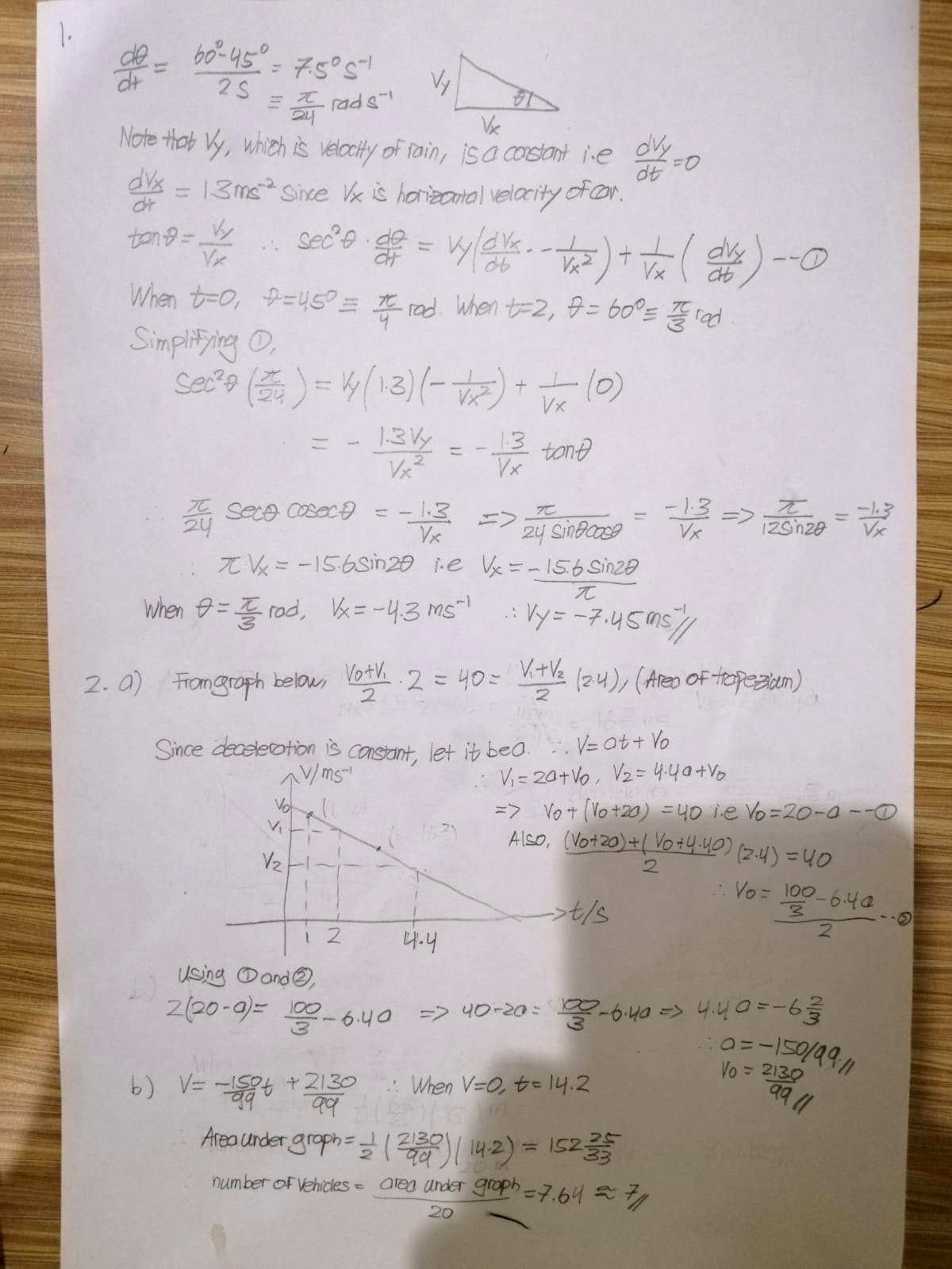Christmas MT's answer to ong yun hui's Junior College 2 H2 Maths Singapore question.
done
{{ upvoteCount }} Upvotes
clear
{{ downvoteCount * -1 }} Downvotes

I know this is past the submission deadline, but I think the questions are quite cool so I'll answer it anyway. I hope you are taking physics.
Question 1
Let Vy be the velocity of the rain which is vertically downwards. Since velocity is a vector it can be positive or negative, which denotes its direction. We let negative be downwards. Similarly, let Vx be the velocity of the car which is parallel to the horizontal. Since the question says that the car is accelerating away from the traffic light, the direction of the acceleration of the car is opposite to the velocity of the car i.e. the sign for dVx/dt is opposite to the sign of Vx. In the answer, we let dVx/dt be positive i.e. sign of Vx is expected to be negative.
The given answer assumes that the rate of change of angle is constant at pi/24 rad s^-1. Since the velocity of the rain is constant, its rate of change, dVy/dt is zero. Given that dVx/dt is 1.3, and the equation relating theta, Vy and Vx is given as:
tan theta = Vy / Vx,
we can differentiate both sides to get equation 1. Simplifying it and substituting the value of theta after two seconds, which is pi / 3 rad, we can solve for Vy, and hence Vx.
Note that although the initial equation is a differential equation, there is no need to do integration because all the derivatives are known constants. We can thus use equation 1 as it is to solve for Vx at angle theta.
Question 2
Since deceleration is constant, we can immediately plot a straight line graph relating V and t. The gradient of this graph will thus be the acceleration (negative to denote that it is decelerating). The y-intercept is V0 which is the velocity of the train when it first passes the person.
We know that the area under this graph, which is the distance travelled by train, is 40 for both the first 2 seconds and the next 2.4 seconds. We can use this information to find both the y-intercept V0 and the acceleration a of the train, as in the picture. I checked that the resulting equation relating V and t gives the correct distance travelled which is 40. The number of vehicles should thus be the area of the triangle i.e. half of the product of the y-intercept and the x-intercept, divided by 20. However, this gives a non-whole number answer. I'm not sure why this is the case, but I suspect that the method is correct. I might have interpreted the question differently, or some rounding-off is expected.
Question 1
Let Vy be the velocity of the rain which is vertically downwards. Since velocity is a vector it can be positive or negative, which denotes its direction. We let negative be downwards. Similarly, let Vx be the velocity of the car which is parallel to the horizontal. Since the question says that the car is accelerating away from the traffic light, the direction of the acceleration of the car is opposite to the velocity of the car i.e. the sign for dVx/dt is opposite to the sign of Vx. In the answer, we let dVx/dt be positive i.e. sign of Vx is expected to be negative.
The given answer assumes that the rate of change of angle is constant at pi/24 rad s^-1. Since the velocity of the rain is constant, its rate of change, dVy/dt is zero. Given that dVx/dt is 1.3, and the equation relating theta, Vy and Vx is given as:
tan theta = Vy / Vx,
we can differentiate both sides to get equation 1. Simplifying it and substituting the value of theta after two seconds, which is pi / 3 rad, we can solve for Vy, and hence Vx.
Note that although the initial equation is a differential equation, there is no need to do integration because all the derivatives are known constants. We can thus use equation 1 as it is to solve for Vx at angle theta.
Question 2
Since deceleration is constant, we can immediately plot a straight line graph relating V and t. The gradient of this graph will thus be the acceleration (negative to denote that it is decelerating). The y-intercept is V0 which is the velocity of the train when it first passes the person.
We know that the area under this graph, which is the distance travelled by train, is 40 for both the first 2 seconds and the next 2.4 seconds. We can use this information to find both the y-intercept V0 and the acceleration a of the train, as in the picture. I checked that the resulting equation relating V and t gives the correct distance travelled which is 40. The number of vehicles should thus be the area of the triangle i.e. half of the product of the y-intercept and the x-intercept, divided by 20. However, this gives a non-whole number answer. I'm not sure why this is the case, but I suspect that the method is correct. I might have interpreted the question differently, or some rounding-off is expected.
Date Posted:
4 years ago

